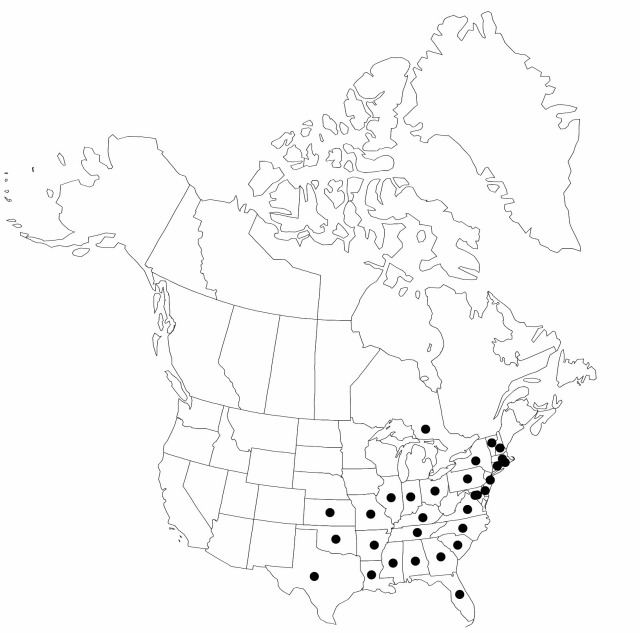Difference between revisions of "Scleria pauciflora"
Sp. Pl. 4(1): 318. 1805.
FNA>Volume Importer |
RevisionBot (talk | contribs) m (Bot: Adding category Revised Since Print) |
||
| (3 intermediate revisions by 2 users not shown) | |||
| Line 6: | Line 6: | ||
|place=4(1): 318. 1805 | |place=4(1): 318. 1805 | ||
|year=1805 | |year=1805 | ||
| + | }} | ||
| + | |special_status={{Treatment/ID/Special_status | ||
| + | |code=F | ||
| + | |label=Illustrated | ||
}} | }} | ||
|basionyms= | |basionyms= | ||
| Line 23: | Line 27: | ||
-->{{Treatment/Body | -->{{Treatment/Body | ||
| − | |distribution= | + | |distribution=Ont.;Ala.;Ark.;Conn.;D.C.;Del.;Fla.;Ga.;Ill.;Ind.;Kans.;Ky.;La.;Mass.;Md.;Miss.;Mo.;N.C.;N.H.;N.J.;N.Y.;Ohio;Okla.;Pa.;R.I.;S.C.;Tenn.;Tex.;Va.;Vt.;Mexico;West Indies (Cuba). |
|discussion=<p>Varieties 2 (2 in the flora).</p><!-- | |discussion=<p>Varieties 2 (2 in the flora).</p><!-- | ||
--><p><i>Scleria ciliata</i> and <i>S. pauciflora</i> are almost universally regarded as distinct species, even though some authors allude to the existence of varying numbers of transitional specimens. Distinguishing them in the herbarium can sometimes be difficult. Some specimens of <i>S. ciliata</i> have the three tubercles on the hypogynium sufficiently deeply bilobed as to make them difficult to distinguish from the paired, discrete tubercles of <i>S. pauciflora</i>. Achene size and leaf width can be helpful with these problematic specimens. Among recent authors, only R. McVaugh (1993) united <i>S. pauciflora</i> and <i>S. ciliata</i>. The western Mexican specimens studied by McVaugh that prompted his uniting of these two species appear, on closer examination, not to be either intermediate between or clearly referable to either species. Detailed study of tropical material similar to <i>S. pauciflora</i> and <i>S. ciliata</i> is much needed.</p> | --><p><i>Scleria ciliata</i> and <i>S. pauciflora</i> are almost universally regarded as distinct species, even though some authors allude to the existence of varying numbers of transitional specimens. Distinguishing them in the herbarium can sometimes be difficult. Some specimens of <i>S. ciliata</i> have the three tubercles on the hypogynium sufficiently deeply bilobed as to make them difficult to distinguish from the paired, discrete tubercles of <i>S. pauciflora</i>. Achene size and leaf width can be helpful with these problematic specimens. Among recent authors, only R. McVaugh (1993) united <i>S. pauciflora</i> and <i>S. ciliata</i>. The western Mexican specimens studied by McVaugh that prompted his uniting of these two species appear, on closer examination, not to be either intermediate between or clearly referable to either species. Detailed study of tropical material similar to <i>S. pauciflora</i> and <i>S. ciliata</i> is much needed.</p> | ||
| Line 57: | Line 61: | ||
|basionyms= | |basionyms= | ||
|family=Cyperaceae | |family=Cyperaceae | ||
| − | |distribution= | + | |distribution=Ont.;Ala.;Ark.;Conn.;D.C.;Del.;Fla.;Ga.;Ill.;Ind.;Kans.;Ky.;La.;Mass.;Md.;Miss.;Mo.;N.C.;N.H.;N.J.;N.Y.;Ohio;Okla.;Pa.;R.I.;S.C.;Tenn.;Tex.;Va.;Vt.;Mexico;West Indies (Cuba). |
|reference=fairey1969a | |reference=fairey1969a | ||
|publication title=Sp. Pl. | |publication title=Sp. Pl. | ||
|publication year=1805 | |publication year=1805 | ||
| − | |special status= | + | |special status=Illustrated |
| − | |source xml=https:// | + | |source xml=https://bitbucket.org/aafc-mbb/fna-data-curation/src/2e0870ddd59836b60bcf96646a41e87ea5a5943a/coarse_grained_fna_xml/V23/V23_448.xml |
|genus=Scleria | |genus=Scleria | ||
|species=Scleria pauciflora | |species=Scleria pauciflora | ||
}}<!-- | }}<!-- | ||
| − | -->[[Category:Treatment]][[Category:Scleria]] | + | --> |
| + | |||
| + | [[Category:Treatment]] | ||
| + | [[Category:Scleria]] | ||
| + | [[Category:Revised Since Print]] | ||
Latest revision as of 18:36, 6 November 2020
Plants perennial; rhizomes clustered, elongate, nodulose, to 5 mm thick, hard. Culms usually in tufts, slender, (15–)20–50 cm, stiff, glabrous or hairy (villous or ciliate in some forms). Leaves: sheaths sometimes reddish, not or scarcely winged, weakly ribbed, short-pubescent or villous; contra-ligules obtuse to triangular, short; blades linear, channeled, obtuse, shorter than or equaling inflorescence, 1–2.5 mm wide, glabrous or pubescent, sometimes scabrous on margins. Inflorescences terminal cluster, sometimes with 1 or 2 axillary clusters, 0.5–1.5 cm, fasciculate; clusters 2–10 mm wide, each with 1–7 spikelets; lateral clusters remote, on long filiform peduncles; bracts subtending inflorescence leaflike, long awl-shaped, often appearing to be continuation of culm, glabrous or ciliate. Spikelets bisexual or staminate, 3–6 mm; staminate scales lanceolate, membranous, pistillate scales ovate-lanceolate, acuminate. Achenes white or gray and/or with black markings, globose or rarely ovoid, 1–2.5(–3) mm, base narrowly constricted, trigonous, apex umbonate, papillate-verrucose, proximal papillae elongate, retrorse, spiculose; hypogynium brownish, bluntly trigonous border, bearing 6 globose tubercles arranged in distinct pairs, usually finely powdery.
Distribution

Ont., Ala., Ark., Conn., D.C., Del., Fla., Ga., Ill., Ind., Kans., Ky., La., Mass., Md., Miss., Mo., N.C., N.H., N.J., N.Y., Ohio, Okla., Pa., R.I., S.C., Tenn., Tex., Va., Vt., Mexico, West Indies (Cuba).
Discussion
Varieties 2 (2 in the flora).
Scleria ciliata and S. pauciflora are almost universally regarded as distinct species, even though some authors allude to the existence of varying numbers of transitional specimens. Distinguishing them in the herbarium can sometimes be difficult. Some specimens of S. ciliata have the three tubercles on the hypogynium sufficiently deeply bilobed as to make them difficult to distinguish from the paired, discrete tubercles of S. pauciflora. Achene size and leaf width can be helpful with these problematic specimens. Among recent authors, only R. McVaugh (1993) united S. pauciflora and S. ciliata. The western Mexican specimens studied by McVaugh that prompted his uniting of these two species appear, on closer examination, not to be either intermediate between or clearly referable to either species. Detailed study of tropical material similar to S. pauciflora and S. ciliata is much needed.
Selected References
Key
| 1 | Plants glabrous or sparsely to densely hairy but not copiously villous-ciliate, hairs not longer than 0.4 mm. | Scleria pauciflora var. pauciflora |
| 1 | Plants copiously villous-ciliate with spreading hairs 0.5–1 mm on culms, leaves, and bracts. | Scleria pauciflora var. caroliniana |